Comments / Questions (92)
![]() Metzger Valerie wrote:
Metzger Valerie wrote:
Bonjour, au niveau des marqueurs sous les bras, je pense. Il faut diminuer 4 fois 4 mailles de chaque côté des marqueurs ou 4 fois 1 maille de chaque côtés ? Merci
06.12.2025 - 06:23DROPS Design answered:
Bonjour Mme Metzger, on diminue 1 m de chaque côté de chaque marqueur = on diminue 4 mailles par rang de diminutions (2 m à chaque marqueur); et ce 4 fois au total tous les 9, 10 ou 11 cm, on va ainsi diminuer 16 m au total: 4 pour chaque devant et 8 pour le dos. Bon tricot!
08.12.2025 - 07:59
![]() Liz Williams wrote:
Liz Williams wrote:
Like the top with buttons
13.11.2025 - 22:50
![]() Angela wrote:
Angela wrote:
I have a question about the pattern. After I finish each piece, I assume I will slip all the stitches on a spare yarn, do I cut the working yarn then cast on the next piece? Thank you! Angela
06.10.2025 - 01:49DROPS Design answered:
Hi Angela, Yes, place the stitches on a thread/stitch holder and cut the yarn before beginning the next piece. Regards, Drops team.
06.10.2025 - 06:41
![]() Magdalena Schumann wrote:
Magdalena Schumann wrote:
Ich soll eine Herrenweste in Drops Nord stricken mit doppeltem Faden. Die mir angegebenen Maße dürften XXXXXL entsprechen, z.B. Bauchumfang 160,2 cm. Die Wahl fiel auf Modell Drops Boston Vest. Wieviel Material werde ich brauchen?
21.09.2025 - 23:23
![]() Halla wrote:
Halla wrote:
Hæ - Pabba minn langar í svona vesti en vill hafa það með vösum. Eru til einhverjar leiðbeiningar um að bæta þeim við?
04.09.2025 - 16:48DROPS Design answered:
Blessuð Halla. Því miður eru ekki vasar á þessu vesti en þú getur skoðað peysur (jakkapeysur) með vösum eins og t.d. peysa nr 0-897 og þar eru leiðbeiningar á hvernig vasar eru gerðir og þú getur þá aðlagað vasana með þeim lykkjufjölda sem þú vilt hafa á vestinu. Gangi þér vel.
06.09.2025 - 12:13
![]() Alexis Nguyen wrote:
Alexis Nguyen wrote:
I have an 8ply super fine merino. About 284 m in each skein. Recommended 3.75 mm needles. I want to use it and another wool to make two vests for my husband. How do I tell if he is a size M or size L? I am in Australia and can measure him in inches or cm. :)
17.05.2025 - 03:29DROPS Design answered:
Dear Alexis, you can check the measurements of the garment in cm in the size chart at the bottom of the pattern; size M would be the second number in each number sequence, size L is the third number. You can find more information on how to read these charts here Remember that, when in doubt, it's recommended to choose the larger size. Happy knitting!
18.05.2025 - 13:15
![]() Karen Hamilton wrote:
Karen Hamilton wrote:
Is there a way to convert this pattern from top down to bottom up and if so, please advise me. Thank you
23.04.2025 - 00:46DROPS Design answered:
Dear Mrs Hamilton, maybe one of these patterns could be helpful? they are worked bottom up. Happy knitting!
23.04.2025 - 08:11
![]() Lone Marrup wrote:
Lone Marrup wrote:
Jeg savner at oplysning om hvor mange masker der er på forstykket, når alle man er færdig med udtagning. (Str M) Og måske også på ryggen. Synes det er en dårlig beskrivelse i opskriften. Jeg plejer ikke have problemer med opskrifterne, men denne opskrift bøvler jeg med. Hilsen Line
20.04.2025 - 19:56DROPS Design answered:
Hej Lone, du starter med 21 masker, tager 19 masker ud til V-hals og 5 til ærmegab = 45 på hvert forstykke og du skal have 90 masker på bagstykket efter hals og ærmegab :)
30.04.2025 - 12:01
![]() Bonnie Banfield wrote:
Bonnie Banfield wrote:
Yes, very helpful! Thank you sooo much. I really appreciate your ongoing assistance and your very prompt responses! I couldn’t have gotten this far without your help. Your instructions are much clearer than those given in the pattern.
17.02.2025 - 16:07
![]() Bonnie Banfield wrote:
Bonnie Banfield wrote:
I must be the thickest person knitting this vest! ;-) Another question - and I hope my last - Purling back from picking up stitches for the button band, where do the extra stitches go? Do you do all the purl stitches and yarn overs go in the same stitch or start like two stitches before the actual pivot and do you purl one, yarn over in each of the two stitches before and after. If you can make any sense of what I’m asking. You’ve been VERY helpful and I so appreciate it. Thank you!
17.02.2025 - 10:19DROPS Design answered:
Dear Mrs Banfield, after you have picked up stitches from RS, purl 1 row increasing where V-increases rises on the front piece, ie at the "tip" after last increase for V-neck, increasing 4 sts to make the V-neck nicer. So in the one stitch just work (P1, YO, P1, YO, P1) = you have now 5 stitches instead of just one on left needle (4 sts increased). Can this help? Happy knitting!
17.02.2025 - 14:32
Boston Vest#bostonvest |
||||
 |
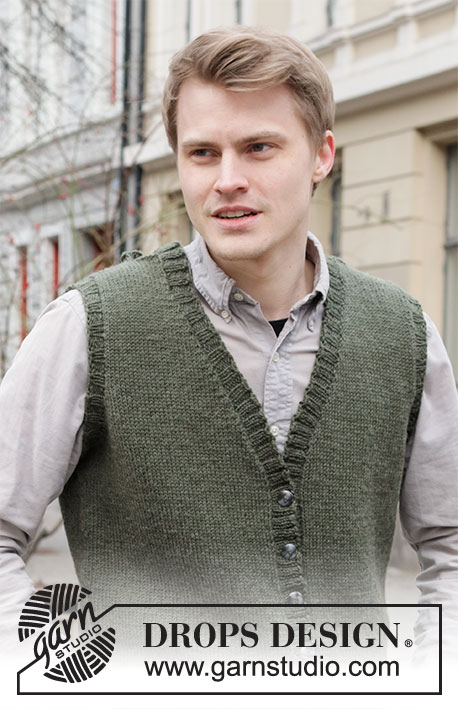 |
|||
Knitted vest for men in DROPS Karisma or DROPS Soft Tweed. The piece is worked top down with V-neck and ribbed edges. Sizes S - XXXL.
DROPS 219-3 |
||||
|
------------------------------------------------------- EXPLANATIONS FOR THE PATTERN: ------------------------------------------------------- RIDGE/GARTER STITCH (worked back and forth): Knit all rows. 1 ridge in height = Knit 2 rows. INCREASE TIP (for V-neck): Make 1 yarn over between 2 stitches. On the next row, work the yarn over twisted to avoid a hole. DECREASE TIP (for sides of body): Decrease 1 stitch on each side of the stitch with the marker thread as follows: Work until there are 3 stitches left before the stitch with the marker thread, knit 2 together, knit 2, slip 1 stitch as if to knit, knit 1 and pass the slipped stitch over the knitted stitch. BUTTONHOLES: Work buttonholes from the right side and on the right band. The bottom buttonhole is worked approx. 2 cm from the bottom edge, the top buttonhole approx.1 cm from the beginning of the v-neck (approx. 32-33-34-35-36-37 cm measured from the bottom of the vest). Work a total of 6 buttonholes with approx. 6-6-6½-6½-7-7 cm between each one. Position them in the purled sections (seen from the right side). 1 buttonhole = purl 2 together, 1 yarn over. On the next row (wrong side) knit the yarn to leave a hole. CASTING-OFF TIP: To avoid the cast-off edge being tight you can cast off with a larger size needle. If the edge is still tight, make 1 yarn over after approx. each 4th stitch at the same time as casting off; the yarn overs are cast off as normal stitches. ------------------------------------------------------- START THE PIECE HERE: ------------------------------------------------------- VEST – SHORT OVERVIEW OF THE PIECE: The vest is worked top down. Each shoulder is worked separately, back and forth, and stitches are increased/cast on for the V-neck and armholes. Then all pieces are joined together and the body finished working back and forth. Stiches are picked up for the neck, sleeve edges and bands, which are worked in rib to finish. FRONT PIECES: Right front piece: Cast on 20-21-21-22-22-23 stitches (including 1 edge stitch on each side) using circular needle size 4 mm and Karisma or Soft Tweed. Work 1 edge stitch in GARTER STITCH – read description above, work stocking stitch until there is 1 stitch left on the row and then 1 edge stitch in garter stitch. Continue like this back and forth. When the piece measures 4-5-5-6-6-7 cm, start to increase for the V-neck and when the piece measures 18-18-18-17-17-16 cm, increase for the armholes, read description below: V-neck: Increase 1 stitch inside the last 2 stitches on the next row from the right side – read INCREASE TIP. Increase like this alternately every 2nd and 4th row a total of 19-19-20-20-21-21 times (increases for the V-neck are not finished when the armhole is finished, but are continued on the body). REMEMBER THE KNITTING TENSION! Armhole: Increase 1 stitch inside the first 2 stitches on every row from the right side 2-1-1-3-4-4 times, then cast on new stitches at the end of every row from the wrong side as follows: Cast on 2 stitches 0-2-2-3-3-4 times and 3 stitches 0-0-1-1-2-3 times (= a total of 2-5-8-12-16-21 stitches increased). Lay the piece to one side and work the left front piece. Left front piece: Cast on 20-21-21-22-22-23 stitches (including 1 edge stitch on each side) using circular needle size 4 mm and Karisma or Soft Tweed. Work 1 edge stitch in garter stitch, stocking stitch until there is 1 stitch left on the row and then 1 edge stitch in garter stitch. Continue like this back and forth. When the piece measures 4-5-5-6-6-7 cm, start to increase for the V-neck and when the piece measures 18-18-18-17-17-16 cm, increase for the armholes, read description below: V-neck: Increase 1 stitch inside the first 2 stitches on the next row from the right side – remember INCREASE TIP. Increase like this alternately every 2nd and 4th row a total of 19-19-20-20-21-21 times. Armhole: Increase 1 stitch inside the last 2 stitches on each row from the right side 2-1-1-3-4-4 times, then cast on new stitches at the end of every row from the right side as follows: Cast on 2 stitches 0-2-2-3-3-4 times and 3 stitches 0-0-1-1-2-3 times (= a total of 2-5-8-12-16-21 stitches increased). Lay the piece to one side and work the back piece. BACK PIECE: Each shoulder is worked separately before being joined together. Right shoulder: Cast on 20-21-21-22-22-23 stitches (including 1 edge stitch on each side) using circular needle size 4 mm and Karisma or Soft Tweed. Work 1 edge stitch in garter stitch, stocking stitch until there is 1 stitch left on the row and then 1 edge stitch in garter stitch. Continue like this back and forth. When the piece measures 4 cm increase 1 stitch inside the first 2 stitches on the next row from the right side = 21-22-22-23-23-24 stitches. Work 1 row back from the wrong side. Lay the piece to one side and work the left shoulder. Left shoulder: Cast on 20-21-21-22-22-23 stitches (including 1 edge stitch on each side) using circular needle size 4 mm and Karisma or Soft Tweed. Work 1 edge stitch in garter stitch, stocking stitch until there is 1 stitch left on the row and then 1 edge stitch in garter stitch. Continue like this back and forth. When the piece measures 4 cm increase 1 stitch inside the last 2 stitches on the next row from the right side = 21-22-22-23-23-24 stitches. Work 1 row back from the wrong side. Now work the 2 shoulders together as follows: Work the 21-22-22-23-23-24 stitches from the left shoulder as before, cast on 36-36-38-38-40-40 stitches (= neck) work the 21-22-22-23-23-24 stitches from the right shoulder as before = 78-80-82-84-86-88 stitches. Work stocking stitch back and forth with 1 stitch in garter stitch on each side. When the piece measures 18-18-18-17-17-16 cm, increase/cast on stitches on each side of the piece for the armholes, in the same way as on the front pieces (= a total of 2-5-8-12-16-21 stitches increased for each armhole) = 82-90-98-108-118-130 stitches. When all the increases are finished, work the body. THE PIECE IS NOW MEASURED FROM HERE! BODY: Now join all the pieces together from the right side as follows: Starting with the left front piece, work 1 edge stitch in garter stitch and stocking stitch as before, then cast on 11-11-13-13-15-15 new stitches (= in side under sleeve), stocking stitch over the 82-90-98-108-118-130 stitches on the back piece, cast on 11-11-13-13-15-15 new stitches (= in side under sleeve), stocking stitch over the right front piece until there is 1 stitch left and finish with 1 edge stitch in garter stitch. The number of stitches on the needle is dependent on how many increases still remain for the V-neck. Insert 1 marker in the middle stitch of the 11-11-13-13-15-15 new stitches in each side. Allow the markers to follow your work onwards; stitches will later be decreased on each side of both markers. When all the increases for the V-neck are finished there are = 186-202-222-242-266-290 stitches on the needle. When the piece measures 5 cm, decrease on both sides of each marker – read DECREASE TIP (= 4 stitches decreased). Decrease like this every 9-9-10-10-10-11 cm a total of 4 times = 170-186-206-226-250-274 stitches. When the piece measures 34-35-36-37-38-39 cm increase 26-26-30-34-38-42 stitches evenly spaced = 196-212-236-260-288-316 stitches. Change to circular needle size 3 mm and work rib, starting from the right side (= knit 2 / purl 2) with 1 edge stitch in garter stitch on each side until the rib measures 4 cm. Cast off with knit over knit and purl over purl – read CASTING-OFF TIP. The vest measures approx.57-59-61-63-65-67 cm from the shoulder down. ASSEMBLY: Sew the shoulder seams with grafting stitches. ARMHOLE EDGE: Knit up 88-132 stitches inside the 1 edge stitch around the armhole with short circular needle size 3 mm and Karisma or Soft Tweed; adjust so the number of stitches is divisible by 4. Work rib in the round (= knit 2 / purl 2) for 2 cm. Cast off with knit over knit and purl over purl – remember CASTING-OFF TIP! Work the other sleeve edge in the same way. RIGHT BAND AND NECK: Starting from the right side at the bottom of the right front piece, knit up 144-172 stitches with short circular needle size 3 mm and Karisma or Soft Tweed, inside the 1 edge stitch, and as far as mid-back of the neck. Adjust so the number of stitches is divisible by 4. Purl 1 row from the wrong side and increase using yarn overs just where the V-neck finishes (i.e. the point, approx. 33-34-35-36-37-38 cm from the cast-off edge upwards), * purl 1, 1 yarn over *, work from *-* a total of 4 times (= 4 stitches increased). On the next row from the right side work as follows: 2 edge stitches in garter stitch, then rib (= knit 2 / purl 2) to end of row (yarn overs worked twisted to avoid holes). Make sure the band is neither too tight nor too loose for the length of the front piece; knit up more/less stitches if necessary. When the band measures 1 cm work the BUTTONHOLES – read description above. When the band/neck measures 2½ cm, Cast off with knit over knit and purl over purl – remember CASTING-OFF TIP. LEFT BAND AND NECK: Starting mid-back of neck with circular needle size 3 mm and Karisma or Soft Tweed and working from the right side, knit up the same number of stitches as on the right band and neck inside the 1 edge stitch down the left front piece. Purl 1 row from the wrong side and increase with yarn overs just where the V-neck finishes (i.e. the point, approx. 33-34-35-36-37-38 cm from the cast-off edge upwards), * purl 1, 1 yarn over *, work from *-* a total of 4 times (= 4 stitches increased). On the next row from the right side work as follows: Work rib (= knit 2 / purl 2) until there are 2 stitches left and finish with 2 stitches in garter stitch (yarn overs worked twisted to avoid holes). When the band/neck measures 2½ cm, Cast off with knit over knit and purl over purl – remember CASTING-OFF TIP. ASSEMBLY: Sew buttons onto the left band. |
||||
Diagram explanations |
||||
|
||||
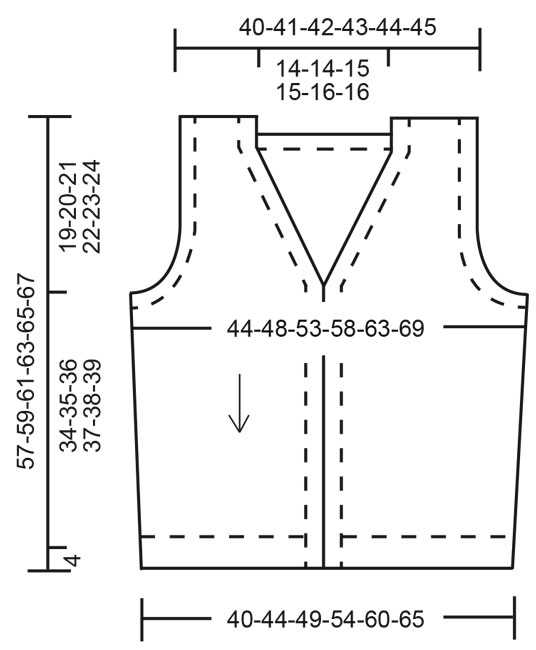 |
||||
Have you finished this pattern?Tag your pictures with #dropspattern #bostonvest or submit them to the #dropsfan gallery. Do you need help with this pattern?You'll find 26 tutorial videos, a Comments/Questions area and more by visiting the pattern on garnstudio.com. © 1982-2025 DROPS Design A/S. We reserve all rights. This document, including all its sub-sections, has copyrights. Read more about what you can do with our patterns at the bottom of each pattern on our site. |
||||







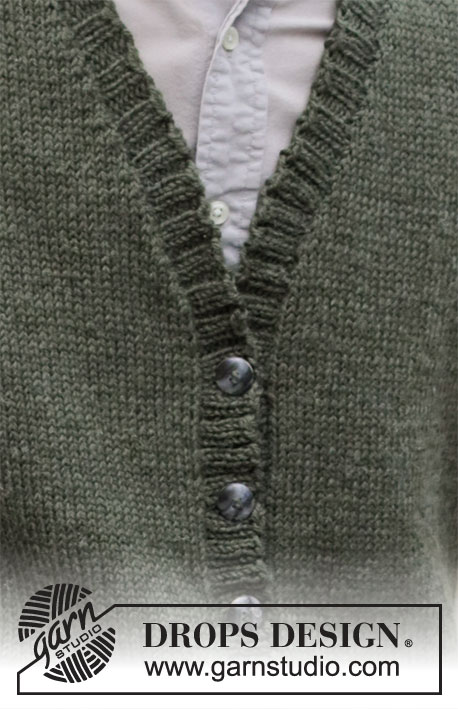

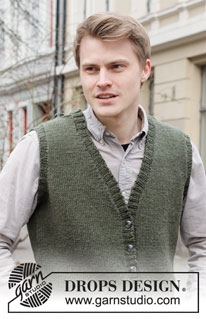
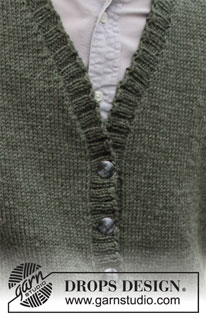



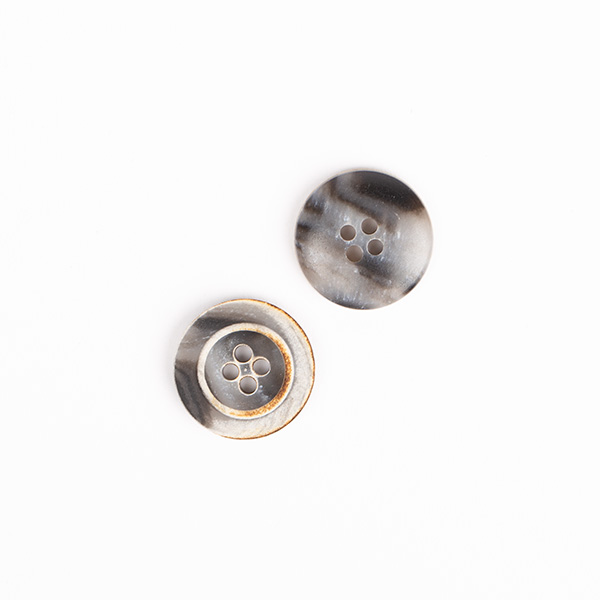

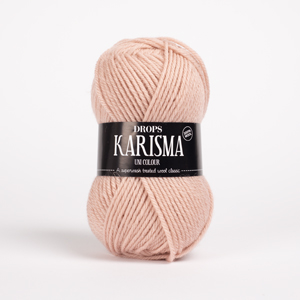


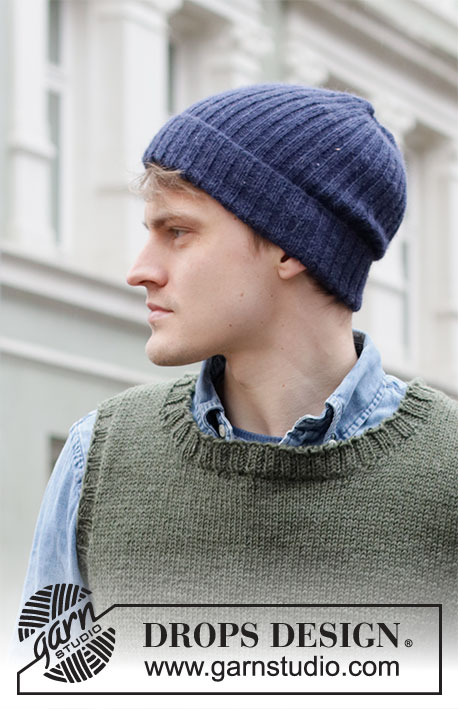














































Post a comment to pattern DROPS 219-3
We would love to hear what you have to say about this pattern!
If you want to leave a question, please make sure you select the correct category in the form below, to speed up the answering process. Required fields are marked *.